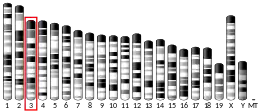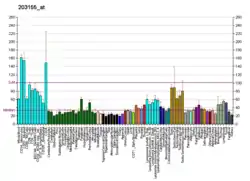| SETDB1 | |||||||||||||||||||||||||||||||||||||||||||||||||||
|---|---|---|---|---|---|---|---|---|---|---|---|---|---|---|---|---|---|---|---|---|---|---|---|---|---|---|---|---|---|---|---|---|---|---|---|---|---|---|---|---|---|---|---|---|---|---|---|---|---|---|---|
| |||||||||||||||||||||||||||||||||||||||||||||||||||
| Identifiers | |||||||||||||||||||||||||||||||||||||||||||||||||||
| Aliases | SETDB1, ESET, H3-K9-HMTase4, KG1T, KMT1E, TDRD21, SET domain bifurcated 1, SET domain bifurcated histone lysine methyltransferase 1 | ||||||||||||||||||||||||||||||||||||||||||||||||||
| External IDs | OMIM: 604396 MGI: 1934229 HomoloGene: 32157 GeneCards: SETDB1 | ||||||||||||||||||||||||||||||||||||||||||||||||||
| |||||||||||||||||||||||||||||||||||||||||||||||||||
| |||||||||||||||||||||||||||||||||||||||||||||||||||
| |||||||||||||||||||||||||||||||||||||||||||||||||||
| |||||||||||||||||||||||||||||||||||||||||||||||||||
| Wikidata | |||||||||||||||||||||||||||||||||||||||||||||||||||
| |||||||||||||||||||||||||||||||||||||||||||||||||||
Histone-lysine N-methyltransferase SETDB1 is an enzyme that in humans is encoded by the SETDB1 gene.[5][6] SETDB1 is also known as KMT1E or H3K9 methyltransferase ESET.
Function
The SET domain is a highly conserved, approximately 150-amino acid motif implicated in the modulation of chromatin structure. It was originally identified as part of a larger conserved region present in the Drosophila Trithorax protein and was subsequently identified in the Drosophila Su(var)3-9 and 'Enhancer of zeste' proteins, from which the acronym SET is derived. Studies have suggested that the SET domain may be a signature of proteins that modulate transcriptionally active or repressed chromatin states through chromatin remodeling activities.[6]
Interactions
See also
- SETD1A, a protein that is highly homologous to SETDB1
References
- 1 2 3 GRCh38: Ensembl release 89: ENSG00000143379 - Ensembl, May 2017
- 1 2 3 GRCm38: Ensembl release 89: ENSMUSG00000015697 - Ensembl, May 2017
- ↑ "Human PubMed Reference:". National Center for Biotechnology Information, U.S. National Library of Medicine.
- ↑ "Mouse PubMed Reference:". National Center for Biotechnology Information, U.S. National Library of Medicine.
- ↑ Harte PJ, Wu W, Carrasquillo MM, Matera AG (June 1999). "Assignment of a novel bifurcated SET domain gene, SETDB1, to human chromosome band 1q21 by in situ hybridization and radiation hybrids". Cytogenet. Cell Genet. 84 (1–2): 83–6. doi:10.1159/000015220. PMID 10343109. S2CID 10805552.
- 1 2 "Entrez Gene: SETDB1 SET domain, bifurcated 1".
- ↑ Schultz DC, Ayyanathan K, Negorev D, Maul GG, Rauscher FJ (April 2002). "SETDB1: a novel KAP-1-associated histone H3, lysine 9-specific methyltransferase that contributes to HP1-mediated silencing of euchromatic genes by KRAB zinc-finger proteins". Genes Dev. 16 (8): 919–32. doi:10.1101/gad.973302. PMC 152359. PMID 11959841.
Further reading
- Nomura N, Nagase T, Miyajima N, Sazuka T, Tanaka A, Sato S, Seki N, Kawarabayasi Y, Ishikawa K, Tabata S (1994). "Prediction of the coding sequences of unidentified human genes. II. The coding sequences of 40 new genes (KIAA0041-KIAA0080) deduced by analysis of cDNA clones from human cell line KG-1". DNA Res. 1 (5): 223–9. doi:10.1093/dnares/1.5.223. PMID 7584044.
- Yang L, Xia L, Wu DY, Wang H, Chansky HA, Schubach WH, Hickstein DD, Zhang Y (2002). "Molecular cloning of ESET, a novel histone H3-specific methyltransferase that interacts with ERG transcription factor". Oncogene. 21 (1): 148–52. doi:10.1038/sj.onc.1204998. PMID 11791185. S2CID 10912876.
- Schultz DC, Ayyanathan K, Negorev D, Maul GG, Rauscher FJ (2002). "SETDB1: a novel KAP-1-associated histone H3, lysine 9-specific methyltransferase that contributes to HP1-mediated silencing of euchromatic genes by KRAB zinc-finger proteins". Genes Dev. 16 (8): 919–32. doi:10.1101/gad.973302. PMC 152359. PMID 11959841.
- Yang L, Mei Q, Zielinska-Kwiatkowska A, Matsui Y, Blackburn ML, Benedetti D, Krumm AA, Taborsky GJ, Chansky HA (2003). "An ERG (ets-related gene)-associated histone methyltransferase interacts with histone deacetylases 1/2 and transcription co-repressors mSin3A/B". Biochem. J. 369 (Pt 3): 651–7. doi:10.1042/BJ20020854. PMC 1223118. PMID 12398767.
- Nakayama M, Kikuno R, Ohara O (2002). "Protein-protein interactions between large proteins: two-hybrid screening using a functionally classified library composed of long cDNAs". Genome Res. 12 (11): 1773–84. doi:10.1101/gr.406902. PMC 187542. PMID 12421765.
- Ayyanathan K, Lechner MS, Bell P, Maul GG, Schultz DC, Yamada Y, Tanaka K, Torigoe K, Rauscher FJ (2003). "Regulated recruitment of HP1 to a euchromatic gene induces mitotically heritable, epigenetic gene silencing: a mammalian cell culture model of gene variegation". Genes Dev. 17 (15): 1855–69. doi:10.1101/gad.1102803. PMC 196232. PMID 12869583.
- Wang H, An W, Cao R, Xia L, Erdjument-Bromage H, Chatton B, Tempst P, Roeder RG, Zhang Y (2003). "mAM facilitates conversion by ESET of dimethyl to trimethyl lysine 9 of histone H3 to cause transcriptional repression". Mol. Cell. 12 (2): 475–87. doi:10.1016/j.molcel.2003.08.007. PMID 14536086.
- Paces-Fessy M, Boucher D, Petit E, Paute-Briand S, Blanchet-Tournier MF (2004). "The negative regulator of Gli, Suppressor of fused (Sufu), interacts with SAP18, Galectin3 and other nuclear proteins". Biochem. J. 378 (Pt 2): 353–62. doi:10.1042/BJ20030786. PMC 1223961. PMID 14611647.
- Colland F, Jacq X, Trouplin V, Mougin C, Groizeleau C, Hamburger A, Meil A, Wojcik J, Legrain P, Gauthier JM (2004). "Functional proteomics mapping of a human signaling pathway". Genome Res. 14 (7): 1324–32. doi:10.1101/gr.2334104. PMC 442148. PMID 15231748.
- Sarraf SA, Stancheva I (2004). "Methyl-CpG binding protein MBD1 couples histone H3 methylation at lysine 9 by SETDB1 to DNA replication and chromatin assembly". Mol. Cell. 15 (4): 595–605. doi:10.1016/j.molcel.2004.06.043. PMID 15327775.
- Goehler H, Lalowski M, Stelzl U, Waelter S, Stroedicke M, Worm U, Droege A, Lindenberg KS, Knoblich M, Haenig C, Herbst M, Suopanki J, Scherzinger E, Abraham C, Bauer B, Hasenbank R, Fritzsche A, Ludewig AH, Büssow K, Buessow K, Coleman SH, Gutekunst CA, Landwehrmeyer BG, Lehrach H, Wanker EE (2004). "A protein interaction network links GIT1, an enhancer of huntingtin aggregation, to Huntington's disease". Mol. Cell. 15 (6): 853–65. doi:10.1016/j.molcel.2004.09.016. PMID 15383276.
- Ichimura T, Watanabe S, Sakamoto Y, Aoto T, Fujita N, Nakao M (2005). "Transcriptional repression and heterochromatin formation by MBD1 and MCAF/AM family proteins". J. Biol. Chem. 280 (14): 13928–35. doi:10.1074/jbc.M413654200. PMID 15691849.
- Verschure PJ, van der Kraan I, de Leeuw W, van der Vlag J, Carpenter AE, Belmont AS, van Driel R (2005). "In vivo HP1 targeting causes large-scale chromatin condensation and enhanced histone lysine methylation". Mol. Cell. Biol. 25 (11): 4552–64. doi:10.1128/MCB.25.11.4552-4564.2005. PMC 1140641. PMID 15899859.
- Gevaert K, Staes A, Van Damme J, De Groot S, Hugelier K, Demol H, Martens L, Goethals M, Vandekerckhove J (2005). "Global phosphoproteome analysis on human HepG2 hepatocytes using reversed-phase diagonal LC". Proteomics. 5 (14): 3589–99. doi:10.1002/pmic.200401217. PMID 16097034. S2CID 895879.
- Stelzl U, Worm U, Lalowski M, Haenig C, Brembeck FH, Goehler H, Stroedicke M, Zenkner M, Schoenherr A, Koeppen S, Timm J, Mintzlaff S, Abraham C, Bock N, Kietzmann S, Goedde A, Toksöz E, Droege A, Krobitsch S, Korn B, Birchmeier W, Lehrach H, Wanker EE (2005). "A human protein-protein interaction network: a resource for annotating the proteome". Cell. 122 (6): 957–68. doi:10.1016/j.cell.2005.08.029. hdl:11858/00-001M-0000-0010-8592-0. PMID 16169070. S2CID 8235923.
- Rual JF, Venkatesan K, Hao T, Hirozane-Kishikawa T, Dricot A, Li N, Berriz GF, Gibbons FD, Dreze M, Ayivi-Guedehoussou N, Klitgord N, Simon C, Boxem M, Milstein S, Rosenberg J, Goldberg DS, Zhang LV, Wong SL, Franklin G, Li S, Albala JS, Lim J, Fraughton C, Llamosas E, Cevik S, Bex C, Lamesch P, Sikorski RS, Vandenhaute J, Zoghbi HY, Smolyar A, Bosak S, Sequerra R, Doucette-Stamm L, Cusick ME, Hill DE, Roth FP, Vidal M (2005). "Towards a proteome-scale map of the human protein-protein interaction network". Nature. 437 (7062): 1173–8. Bibcode:2005Natur.437.1173R. doi:10.1038/nature04209. PMID 16189514. S2CID 4427026.
- Orouji E, Federico A, Larribere L, Novak D, Lipka DB, Assenov Y, Sachindra S, Hueser L, Granados K, Gebhardt C, Plass C, Umansky V, Utikal J (2019). "Histone methyltransferase SETDB1 contributes to melanoma tumorigenesis and serves as a new potential therapeutic target". Int J Cancer. 145 (12): 3462–3477. doi:10.1002/ijc.32432. PMID 31131878.
- Strepkos D, Markouli M, Klonou A, Papavassiliou AG, Piperi C (2021). "Histone methyltransferase SETDB1: A common denominator of tumorigenesis with therapeutic potential". Cancer Research. 81 (3): 525–534. doi:10.1158/0008-5472.CAN-20-2906. PMID 33115801. S2CID 226046421.
- Cao N, Yu Y, Zhu H, Chen M, Chen P, Zhuo M, Ye M (2020). "SETDB1 promotes the progression of colorectal cancer via epigenetically silencing p21 expression". Cell Death & Disease. 11 (5): 351. doi:10.1038/s41419-020-2561-6. PMC 7214465. PMID 32393761.
- Lee S, Lee C, Hwang CY, Kim D, Han Y, Hong SN, Cho KH (2020). "Network inference analysis identifies SETDB1 as a key regulator for reverting colorectal cancer cells into differentiated normal-like cells". Molecular Cancer Research. 18 (1): 118–129. doi:10.1158/1541-7786.MCR-19-0450. PMID 31896605.
- Fukuda K, Shinkai Y (2020). "SETDB1-Mediated silencing of retroelements". Viruses. 12 (6): 596. doi:10.3390/v12060596. PMC 7354471. PMID 32486217.
External links
- FactorBook SETDB1
- Overview of all the structural information available in the PDB for UniProt: Q15047 (Histone-lysine N-methyltransferase SETDB1) at the PDBe-KB.
This article incorporates text from the United States National Library of Medicine, which is in the public domain.





